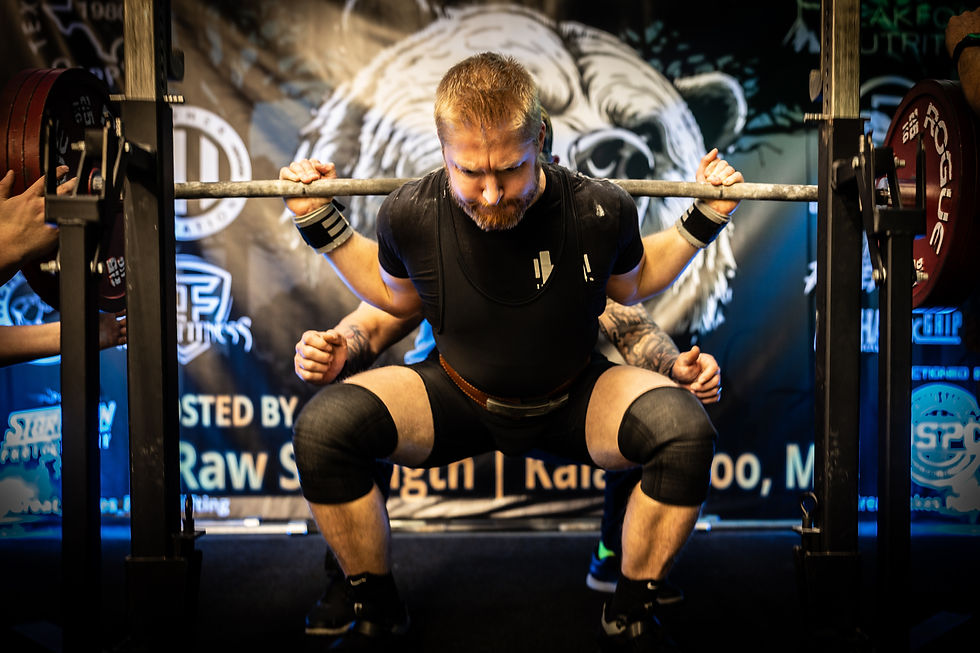Friday Five: The Best (Essential) Gym Bag Accessories
- Jordan Van Dyk

- Apr 12, 2024
- 3 min read
It is rare that anything you put on your body can be called essential, but there are a few gym accessories that will support your continued progress. These items have specific functions that improve your ability to use your body, and are the items where your money is best spent.
1. Shoes

Your feet are your foundation in most every exercise you do. Having low-quality shoes, or even what you'd consider high quality shoes that have a soft sole, can have a very negative effect on your ability to lift safely. "Olympic" lifting shoes have a few features you should know about: First, they have a hard sole and arch support. The arch support provided by lifting shoes can keep your feet much healthier by supporting the foot as it supports potentially hundreds of additional pounds on your feet. These shoes also sport a metatarsal strap, ensuring a snug fit and no movement of your foot within the shoe. The hard sole not only helps with the support of your foot, but also creates a wider, more well distributed surface from which to push from. Lifting shoes have a heel on them, all of which range from around .75-1.25 inches. This allows further forward traveling of the knee in the squat and puts your hips in an advantageous position. All these considerations put them on top of this list.
2. Belt

Next on the list is the lifter's belt. Belts support the lifters core by allowing the lifter to brace more effectively. It's a weird trick of the human body that we can produce more force against resistance than we can without it, and a belt provides resistance against your core musculature, allowing you to create a stronger core when performing movements such as Squats, Deadlifts, Presses, etc. If you're going to buy a belt, don't get the cheap velcro ones from your local supermarket or sporting goods store. Get a thick (10-13 mm) leather belt that will last a lifetime. These belts are a bit more pricey but worth every penny. I recommend a 3-inch belt with a prong. 4-inch belts are too big for most people and actually interfere with their ability to extend their back into the right position for Deadlifting. Lever belts are cool (especially when you can flick them loose after a PR!) but they are a bit of an annoyance if you're hovering between hole sizes. Adjusting them is an extra pain you can avoid by just buying a prong belt.
3. Wrist straps


Over time, wrist straps have climbed higher and higher on this list. Wrist straps wrap around the bar to give the lifter the ability to hang on to loads they normally would not be able to hang on to. You might be thinking, "If a lifter can't hold on to the bar, it's too much weight," but that really isn't true. For example, when training the Deadlift, the back can tolerate much higher loads than the hands often allow. Since the Deadlift is supposed to train the back primarily, that's what we will use it for. The same will go for RDLs. You would be leaving many, many reps on the table (and thus, not making as much progress) if you quit when your hands had to. The strength of the hands does improve even with the use of such wraps, but often lags behind the rest of the bodies potential.
4 and 5. Knee sleeves and Wrist Wraps
The next two items on this list are sort of like vitamins: they are there to prevent problems from happening in the future. Knee sleeves slide tightly around the knee to provide compression and maintain heat. This helps prevent inevitable aches, but also gives the lifter feedback about the position the knee is in.
Wrist wraps provide support around the wrist, which help it from bending and compressing when pressing against heavy loads. The wrist, being a small joint, benefits greatly from this extra support.


Knee sleeves come in a pretty wide variety- different thicknesses, materials, etc. Some even provide a bit of "rebound" out of the bottom of a Squat that can aid you in getting a few extra pounds up, although I wouldn't recommend going in search for those unless you plan on competing. I would recommend sleeves that are 7mm in thickness.
Wrist wraps also come in many varieties of length and thickness. I would recommend 3-inch wraps that are 60cm in length.
Conclusion
There aren't many items that will give you the benefit that these will make in your training experience immediately. These are the best gym accessories that your money can go toward, because they help support your training goals significantly. Some honorable mentions for this list were Elbow Sleeves, the Slingshot, a Bench Block, resistance bands, and Occlusion bands.



Comments